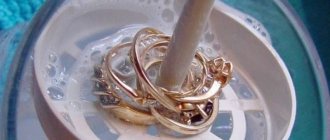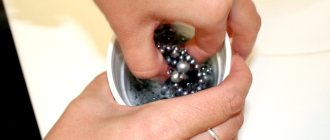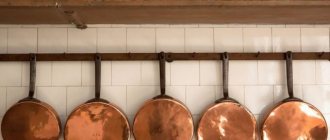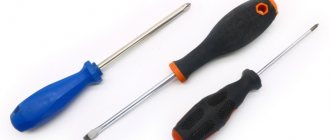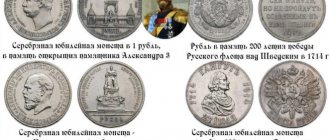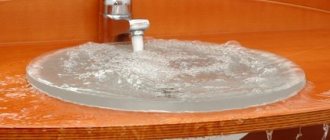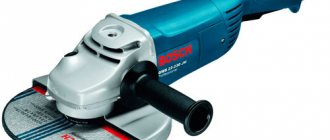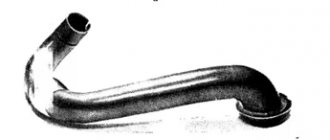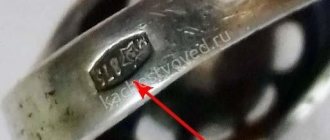Cupronickel has long been used as a raw material for the manufacture of various products, such as tableware, coins and jewelry. Outwardly, it resembles silver, but this alloy of copper and nickel is a more budget option. There are such products in almost every home, so their owners are faced with the main disadvantage of products made from this alloy - dark patina spots that appear over time, which greatly spoil the appearance of things.
Why do products darken?
There are many reasons for the darkening of cupronickel objects:
- Excessive air humidity;
- Improper care and storage.
Each product made of cupronickel requires special care and cleaning. The peculiarity of such dishes is that food particles can get into microcracks on its surface or relief patterns. This can significantly reduce the visual appeal of the product. And high humidity, in addition, greatly affects the oxidation process of the cupronickel surface.
This is due to the copper content in this alloy. Therefore, such things should be stored exclusively in dry places . After washing the dishes, you need to diligently wipe them from any remaining drops of water.
Remember, water is the worst enemy for cupronickel .
A little history
Cupronickel as such does not exist in nature: in fact, it is a group of compositions made of copper with the addition of nickel, iron, zinc, manganese and some other metals. Most often it is an alloy of copper and nickel, which has its own specific features and properties. According to historical sources, it was invented in China in the 8th century BC and given the sonorous name “pakfong”. All attempts to unravel the composition of “Chinese silver” by European alchemists were unsuccessful: only by the beginning of the 19th century did mass production of nickel silver begin in Germany. At first, the European nobility considered such dishes to be “the dishes of the poor,” and therefore still preferred dishes made of other metals - gold and silver. Only by the 20th century did production increase its speed everywhere. The attractive appearance of cupronickel was used to make cutlery, candlesticks, jewelry and other decorative elements. Wear-resistant, easy to maintain and not too expensive, the alloy is appreciated and actively used in household use.
Interestingly, psychologists consider cupronickel tableware to be beneficial for the psyche. The unobtrusive, calm, noble shine of the alloy calms the nervous system, relieves tension and sets you to a calm rhythm.
How to clean nickel silver from blackness?
Nowadays you can find a large number of different cleaning products on store shelves. These include powders, gels, and solutions for cleaning nickel silver from dirt. They are easier in terms of time and effort spent on cleansing.
The easiest and most convenient way is to use gels or other liquid products. Also a very effective way to combat stains is abrasive powder. But it has a big drawback - it scratches the surface. Therefore, it is better not to use it to clean cutlery .
It is also not recommended to use products containing chlorine, as it can damage the surface of cupronickel items.
What to do to prevent a black coating from appearing on cupronickel cutlery
How to care for cupronickel to ensure your products have an excellent appearance:
- We always wipe knives, forks and spoons made of cupronickel dry;
- We store the products in zip bags with a convenient lock that will perfectly protect the contents from moisture and dust;
- Tableware should be regularly wiped with a soft flannel cloth, coarse woolen cloth, or use a special napkin for cleaning silver;
- A wooden box that closes tightly is also good for storing equipment. You need to put a piece of chalk inside it, which will protect the products from oxidation.
These methods are very effective and not at all labor-intensive.
How to clean cupronickel at home
If you decide to clean nickel silver products with ordinary “folk” means, it will not cost much. All methods are quite economical for your budget.
You can use:
- Tooth powder or paste.
Take a dry cloth and any toothpaste. Squeeze a little paste onto a cloth and wipe the nickel silver items until the black spots disappear;
- Baking soda.
You can use it, as in the case of toothpaste, or put it in boiling water, and boil the blackened dishes in the resulting soda solution for several minutes;
- Powdered chalk.
A more costly method in terms of time and effort. Chalk must first be ground into a fine powder, and then objects must be polished with this powder. Fine chalky “sand” has a tendency to get clogged into the recesses of the decor of dishes, so it will take a lot of patience to clean everything perfectly clean;
- Ammonia.
It can be used in the same way as baking soda.
- eggshells.
Use shells from raw eggs only; they will not work after boiling. Wash it well and grind it to a powder. Pour one tablespoon into boiling water. salts and powder from the shell, then lower the items for 15-20 minutes until the blackness is completely cleared;
- Medical alcohol.
Soak items in an alcohol solution;
- Lemon acid.
For 1 liter of water you will need 100 grams of acid. The products need to be boiled for 20-30 minutes until the blackness disappears completely.
- Foil.
You can read about this method of cleaning cupronickel in a separate paragraph below.
Before cleaning the surface of the metal, you must first clean it of dirt and grease that has accumulated in the relief recesses.
Do not use sandpaper or hard brushes, they will only scratch and damage the metal, but gentle abrasives (chalk, tooth powder, etc.) will gently clean the surface of dirt.
After cleaning, wash the items well in warm water and wipe dry thoroughly. Do not leave the devices wet, otherwise the black spots will return again.
Cleaning gold plated appliances
For luxury gold-plated items, there are several simple methods for removing stains. Let's look at how to clean nickel silver in this case:
- We soak a piece of cotton wool in turpentine or wine vinegar (or a napkin in alcohol) and wipe the gilding with it. But you cannot rub too hard - such products do not tolerate mechanical impact, because the gilding can quickly wear off;
- Rub the alloy with a flannel cloth with egg white applied to it.
Just in case! We wrote in this article how and with what to purify gold.
Clean cupronickel with foil
Foil helps to eliminate unsightly dark spots that spoil beautiful spoons and forks. You will need:
- Food foil;
- 4 tbsp. l. baking soda;
- Pan or bowl.
Place foil on the bottom of the pan, pour baking soda into it and lower the utensils into it. Pour boiling water over it. During a chemical reaction, the foil absorbs all the blackness, leaving the surface of the dishes clean and shiny.
You can boil it several times if the contamination is too strong. However, it is better not to use this method on dishes with gold or silver finishes. Otherwise, the whole decoration will come off.
In this video tutorial, Oleg Karpov will show you exactly how to clean nickel silver using foil:
Chalk polishing
The most common chalk can be used to polish cutlery items to a shine and remove minor dirt from them.
Polishing procedure:
- Grind the chalk into powder;
- Add a little water until you get a viscous slurry;
- We take a soft cloth (without lint) and apply the mixture on it, with which we polish the products.
If you don’t have chalk, then a non-abrasive toothpaste with silicon oxide in its composition is great for these purposes. It is applied to a damp cotton pad and can be used to clean nickel silver spoons, forks and knives.
Soda and vinegar for darkening
These two ingredients are available in every kitchen, so you don't have to buy anything extra to complete the cleaning procedure. You will need a liter of water and 50 grams of baking soda.
- Stir baking soda into water.
- Wipe the cupronickel accessories with the resulting soda solution until the darkening disappears.
- To improve the effect, you can add salt.
Instead of soda, you can use one teaspoon of wine or table vinegar per 200 ml of water. True, such a simple solution has its drawback - vinegar will not be able to cope with stubborn dirt and blackness, but it is perfect for giving products a pleasant, clean look.
Prevention and care rules
The gold plating wears off over time. Constant use leads to a gradual thinning of the spray layer. By following some recommendations you can extend the service life. Rules for caring for gold-plated products:
- Regularly polish cutlery and decorations using a suede cloth.
- Minimize contact with water, perfume and body creams.
- Place each product separately, so that they do not touch each other. After each use of jewelry, put it back in place. Distribute each decoration into separate suede bags, and cutlery into special boxes.
Clean regularly, regardless of whether the product has lost its attractive appearance or not.
Cutlery made of cupronickel, as well as silver, is found in almost every home. So I, while cleaning out my parents’ closets, came across a small box with teaspoons made of cupronickel with gold plating. But after lying unnecessarily for thirty years, they acquired a very deplorable appearance.
In search of information on how to clean cupronickel spoons, I looked through a lot of different sites and found many fairly simple ways to eliminate this terrible coating on spoons. In practice, I decided to try several cleaning options using simple home remedies as an experiment.
To begin with, I tried to simply wash the spoons using my usual dishwashing detergent, but this, of course, had no effect on the plaque.
So we'll experiment. 1 way. Cover the bottom of a stainless (or enamel) container with foil and place spoons. Pour in 60 g of soda ash and 40 g of salt.
Fill with hot water so that the objects are completely covered with it. Place the container on the stove and boil for 15 minutes over low heat (so that the signs of boiling are barely noticeable). The spoons begin to lighten right before our eyes.
We rinse them with clean water to remove traces of soda and salt, and wipe them dry with a soft cloth. There was no trace left of the black spots.
This cleaning method is not recommended if nickel silver items have gold plating. But I still took the risk. The gilding has become somewhat lighter, but this is not a problem.
Method 2. Apply a little toothpaste to a cotton pad (you can also use powder) and rub the nickel silver spoon, of course, with a little effort. And the spoons sparkled again with their original shine. What an effect!
3 way. Pour a liter of water into a saucepan, put it on fire, throw in the crushed shells of two eggs (raw) and 30 g of salt.
As soon as the water boils, we place cupronickel spoons in it, boil for literally two minutes, and... all efforts were in vain. The spoons have not changed at all.
Method 4 is intended specifically for nickel silver with gilding. Wet a ball of cotton wool with apple cider vinegar (you can also use egg white, turpentine or wine vinegar) and rub the spoon with it thoroughly. Alas! Again no positive result. I even tried to soak the spoon in a pure vinegar solution for several minutes, but to no avail.
5 way. Grate the peeled potato tuber on a fine grater and dip cupronickel spoons into the pulp.
Perhaps this cleaning method is the safest, since there is no need to rub or boil, much less use chemicals. Only natural ingredients. True, there is no sense in it either. All the blackness remained in place.
Here are 5 ways I've tried to clean cupronickel silver cutlery. What I liked most was the option using toothpaste. It was with this that I cleaned all the spoons that took part (to no avail) in other experiments. The paste instantly removes all the blackness.
Decoctions for cleansing
You can also prepare special cleansing infusions. This is another wonderful folk remedy that will help you cope with even the most severe stains.
Suitable for preparing the decoction:
- Garlic peel;
- Potato.
Potato broth is considered less effective, but the most gentle. It does not harm the surface of products, so you can safely use it for items with gold or silver inserts.
A decoction of garlic peels is prepared as simply as possible. The husk needs to be boiled, and the more of it, the better the broth will cope with darkened spots.
Thus, you can restore the former sparkling appearance of cupronickel accessories in different ways, without spending money on additional cleaning products. The main thing is to take care of such items in a timely manner , to prevent water from getting into the places where they are stored, then they will always be in excellent condition.
Special products for cleaning cupronickel items
Currently, you can find many different chemicals for removing darkening from the top layer of cupronickel. It is recommended to choose compounds used specifically for cleaning copper-nickel alloys, so that when cleaning and polishing objects from plaque, you do not damage the dishes.
Such compositions are produced:
- water based;
- in the form of a gel;
- in the form of a creamy substance;
- special napkins.
If the products used for cupronickel are not on sale, then before purchasing, you need to make sure that the selected household chemicals do not contain chlorine or particles of abrasive material.
In appearance, cupronickel silverware is no different from precious metals, which is why you can choose a jewelry product to remove dark stains.
When choosing a product, you should give preference to one that is not easy to clean cupronickel, but creates a protective film on the item that protects it from environmental influences.
Pros and cons of the material
Cupronickel silver cutlery has many advantages and disadvantages. They stand out from the bulk of the dishes with their appearance. The main advantages include the following qualities:
Products made from copper alloy are very similar to devices made from precious metal.
- durability;
- corrosion resistance;
- external resemblance to noble silver;
- heat resistance;
- affordable price;
- long service life.
But there are also disadvantages. Over time, stains appear on the surface, so you need to clean nickel silver from blackness regularly. When using abrasive products, scratches appear. Therefore, you should choose other cleansing methods. In addition, nickel silver spoons and forks cannot be washed in the dishwasher. Exposure to water and chemicals accelerates the formation of dark spots.
Sodium thiosulfate
Sodium thiosulfate is a medication that doctors prescribe to relieve inflammation and detoxify.
It is useful to have the medicine in your home medicine cabinet so that you have something to clean cupronickel. The medicine is sold in powder or solution form.
How to clean cupronickel products:
- There is no need to dilute the drug with water. It is better to use it in concentrated form, as its effect is enhanced.
- Put on gloves, take a sponge and apply the powder or solution to the surfaces of the cutlery. Scrub the kitchen utensils thoroughly, making sure not to miss a single area.
- Leave for 5 minutes.
- Wash under running water.
Sodium thiosulfate perfectly cleanses any contaminants. It will remove even old blackness.
